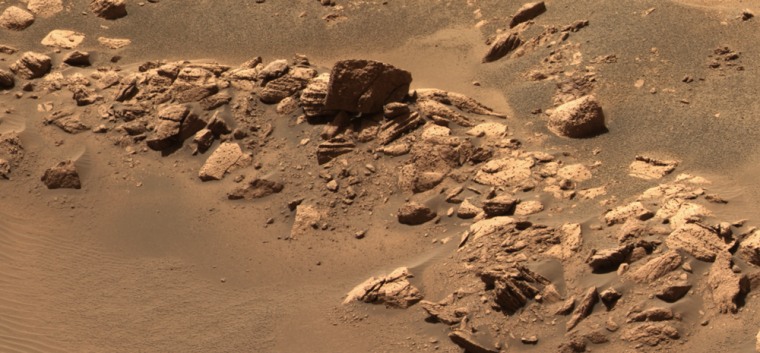The Spirit rover set a personal best Wednesday for distance driving on Mars while its twin, Opportunity, got to within a two-day drive of the highly anticipated Endurance Crater.
In the broad Gusev Crater, the Spirit robot crawled 290 feet (88.5 meters) on Wednesday, its longest effort. The robot has logged 0.81 miles (1,315 meters) since landing on Mars in January.
Spirit is headed for the Columbia Hills, still about 1.2 miles (2 kilometers) away. The rover is taking pictures and measurements of soil and rocks each day and is expected to reach its destination by mid-June.
Scientists will use the long line of ground measurements, including temperature readings of the rock and soil, to calibrate the accuracy of what they see from space with orbiting craft.
At Columbia Hills, scientists hope to find ancient rock outcroppings that will hold clues to the water history of the region. Mission managers are trying to get "as much mileage on the vehicle as we can manage," mission manager Matt Wallace said during a press briefing at NASA's Jet Propulsion Laboratory.
Beyond the primary mission
Both rovers have completed their 90-day primary missions and are in extended operating mode, which is to say in some sense it's all gravy from here on out. If all goes well, they should operate through the summer.
Like Opportunity, Spirit was recently outfitted with new software, beamed from Earth, which allows it to travel about three times farther in a day than was possible before, Wallace said. Spirit has covered more ground in April than in the rest of its mission combined.
The robot must now navigate a mix of soft sand, rock fields, depressions and craters. "The terrain here is not easy to navigate," Wallace said.
The early portions of both missions were spent exploring the landing sites. Now scientists are eager to see how the broader regions are similar or different.
Opportunity's course
Opportunity has so far driven about a half-mile (812 meters), Wallace reported Wednesday. Its longest drive — a record on Mars — was 463 feet (141 meters).
Mission planners have attempted to trace the geology of Meridiani Planum as Opportunity has raced toward Endurance crater. At a large trough called Anatolia, the rover found rock outcrops similar to those at its Eagle Crater landing site, which revealed an ancient lake or sea.
At another crater called Fram, a similar outcrop was studied in cursory fashion. Despite some rock features that appeared "tantalizingly different" compared to Eagle Crater, Fram did not seem to offer enough promise to command a lengthy investigation, said Scott McLennan, a science team member from the State University of New York at Stony Brook. Depending on how the rest of the mission goes, scientists might decide to return to Fram.
Pictures from Opportunity have revealed the far rim of its next stop, the Endurance Crater. Scientists and engineers will soon see the inside and begin discussions over the safety and scientific value of possibly driving down into the crater. Taller outcropping there may hold a much longer historical record of water in the region, scientists say.
"In the next week or so we're going to have a lot of fun making those decisions," McLennan said.
